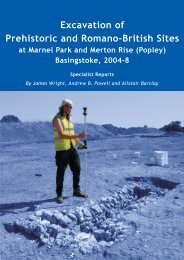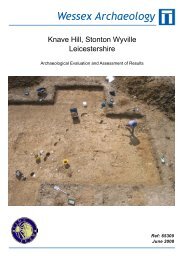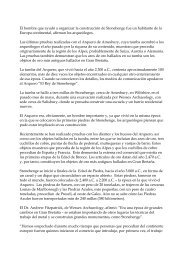Knave Hill, Stonton Wyville, Leicestershire - Wessex Archaeology
Knave Hill, Stonton Wyville, Leicestershire - Wessex Archaeology
Knave Hill, Stonton Wyville, Leicestershire - Wessex Archaeology
Create successful ePaper yourself
Turn your PDF publications into a flip-book with our unique Google optimized e-Paper software.
the calculation of a height at the withers of c 56 cm (Teichert 1975). This is anormal value.5.7.4 The upper fill of pit (150) contained the partial skeleton of a sheep. Bothtibiae, two ribs, a scapula and a pelvis fragment as well as part of a humeruswere present. The unfused status of the bones indicates a lamb below 3-4months. As the total length of the tibia was well over that of a neonate(Habermehl 1975), the lamb was probably a few weeks to months old.5.7.5 Posthole (421) contained a bone pin/needle made out of the proximal part ofa horse splint bone. Some of the proximal articulation was still visible. Thedistal part was fashioned into a sharp point and the shaft rounded. Atransverse hole was made through the top. The whole object was highlypolished through use. The date of the object is uncertain since no other datingevidence was recovered from this feature, but it is within a possiblerectangular building outline dated as Anglo-Saxon.5.8 Other Finds5.8.1 Other finds comprise small quantities of ironworking slag; a few fragmentsof lava quernstone (of either Romano-British or Anglo-Saxon date); and oneslab-like piece of limestone, possibly utilised as building material.6 PALAEO-ENVIRONMENTAL EVIDENCE6.1 Introduction6.1.1 Seven samples were taken from the excavations. Those from Trench 1 camefrom four Romano-British and probable Romano-British pits (142, 150, 146and pit/posthole 154). Those from Trench 4 came from probable Anglo-Saxon contexts, a hearth deposit (438) and occupation layer (441). Thesamples were processed for the recovery and assessment of charred plantremains and charcoals.6.1.2 The bulk samples were processed by standard flotation methods; the flotretained on a 0.5 mm mesh, residues fractionated into 5.6 mm, 2mm and1mm fractions and dried. The coarse fractions (>5.6 mm) were sorted,weighed and discarded. Flots were scanned under a x10 – x40 stereobinocularmicroscope and the presence of charred remains quantified (Table3) to record the preservation and nature of the charred plant and woodcharcoal remains. Preliminary identifications of dominant or important taxaare noted below, following the nomenclature of Stace (1997).6.1.3 The samples were generally quite rooty with the exception of those from pit(154) and small pit (146), which were mainly pure charcoal. The degree ofrooting and modern seeds is a good indication of soil activity and thepossibility of later intrusive elements being brought into the context, orreworking of earlier material. This is particularly an issue for the featureswithin Trench 4 where the degree or rooting was very high, including largestems of modern straw and straw roots.12





